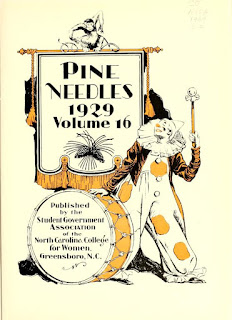Perhaps more than any other campus publication, the school yearbook is the most reflective of the college’s physical environment, the interests of the students, the styles of the times, and even the social and political climate of the county. For the first ten years after the State Normal and Industrial School (now The University of North Carolina at Greensboro) opened in 1892, there was no official yearbook. This omission was rectified in 1902 when the Cornelian and Adelphian Literary Societies published a history of the first ten years of the college. The students named the publication The Decennial and dedicated it to the first president and founder of the college, Charles Duncan McIver. The Decennial listed the student classes from 1892, each with a class history. Images of students were also included, as well as academic and social clubs, athletic teams, dramatic organizations, and campus events. Student clubs echoed the young women’s interest in fun, but also in societal concerns as they established more socially-minded groups such as The Young Women’s Christian Temperance Union and the Women’s Association for the Betterment of Public School Houses in North Carolina.
By the end of the 19th century, women were not only increasingly involved with community issues, but they were also beginning to occupy significant roles in the workforce. This trend can be seen in The Decennial in which student essays titled “Thoughts and Experiences of a Business Woman” and “A Woman’s Opportunities in the Business World as I Have Found Them,” extolled the benefits of business training for women and hoping for the achievement of equal pay.
In 1909, the first true annual, named The Carolinian, was published. It replicated the same basic format at The Decennial, and it was also dedicated to President McIver. Meant to give “a more appreciative knowledge and a more sympathetic understanding” of State Normal, the publication included photographs of the faculty and of each student class, with class histories, songs, toasts, and poems. The seniors had the privilege of choosing a special quotation and a current and childhood photograph. They also wrote a Class Prophecy, imagining what the students would be doing in the future, as well as a “Last Will and Testament,” passing along certain valued items and well wishes to the classes that followed.
The following pages included photographs of students who participated in academic and social clubs, athletics, dramatic organizations, and campus events. The last part of the yearbook contained essays penned by students from various classes; images of the campus; superlatives; and even jokes.
The campus yearbook continued to be published annually, except for 1912 and 1916 when the funds were used instead to present elaborate campus May Day celebrations, and 1919 when the country was embroiled in World War I and the students created scrapbooks instead. The same year, the school started its own weekly student newspaper. Born from a creative writing class during the war years, students decided to name the new publication after the yearbook, The Carolinian. The yearbook needed another name. Inspired by the first lines of the state toast, “Here’s to the land of the long-leaf pine…,” the first edition of the new NCCW yearbook, published in 1920, took the name Pine Needles.
The yearbook continued to use the same format as in previous years, including photographs of students, campus grounds, and organizations; superlatives; and essays. Written tongue in cheek, the 1920 Pine Needles features the essay, “Confessions of a Dope Fiend,” tells the story of a Coca-Cola induced crazed dream during which a student saw her college friends in the future.
After the war years, Pine Needles reflected the social changes that were being felt throughout the country. Students bobbed their hair like popular actresses of the time and clothing became less constricting. Additionally, the college was undergoing tremendous growth, and the yearbook always included the many new buildings being constructed on campus.
The 1920s also ushered in some of the most creative designs in the history of the publication. Two notable examples are the 1929 circus theme edition and the 1930 yearbook which featured images inspired by Carl Sandburg’s book of poems, “Good Morning, America.” The Sandburg-inspired edition encompassed colorful images of nature as well as striking cityscapes into the decorative treatment. As the college moved into the 1930s, it underwent important transformations.
  |
| Images from the circus themed 1929 Pine Needles (p. 7) and the Sandburg inspired 1930 edition (p. 13) |
In 1932, the school officially consolidated with the University of North Carolina and North Carolina College of Agriculture and Engineering, and was renamed the North Carolina College for Women. Part II of The History of the College’s Yearbook will cover how Pine Needles reflected these changes.
By Kathelene McCarty Smith



